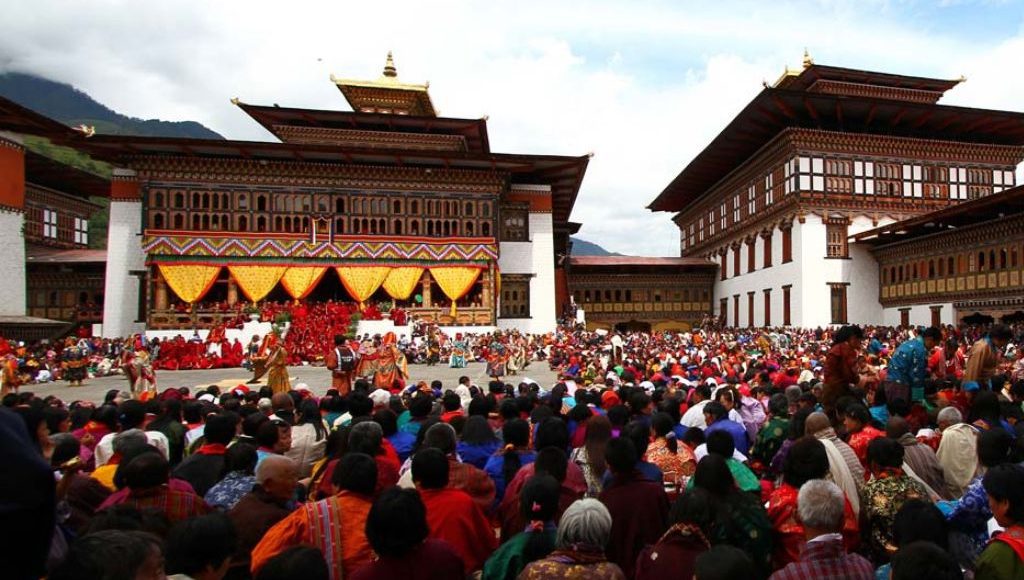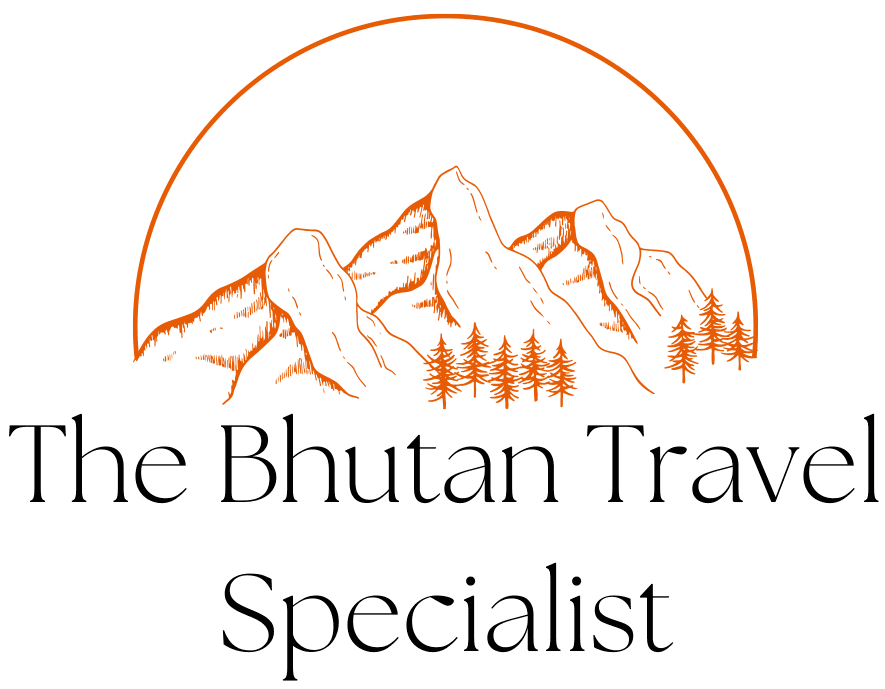Do not hesitate to give us a call. We are an expert team and we are happy to talk to you.
(+975) 17953762

Overview:
Embark on a 9-day journey through Bhutan, experiencing the vibrant Thimphu Tshechu Festival and exploring the country’s cultural and natural wonders. Begin in Paro and travel to Thimphu, immersing yourself in the lively city and joining the Thimphu Tsechu Festival at the magnificent Tashichho Dzong. Witness mesmerizing mask dances, attend archery matches, and savor Bhutanese cuisine. Explore Thimphu’s landmarks, including the National Memorial Chorten and Handicraft Market, against the backdrop of the illuminated Tashichho Dzong. Continue your adventure to Punakha, where you’ll explore Punakha Dzong, experience thrilling rafting, and visit Chimi Lhakhang. Journey to Gangtey for yoga and meditation, then proceed to Bumthang for cultural exploration. Conclude in Paro with a visit to the iconic Tiger’s Nest Monastery.
Tour Highlights:
1. Witness the Thimphu Tshechu Festival at Tashichho Dzong.
2. Experience traditional Bhutanese attire, mask dances, and archery matches.
3. Explore Thimphu’s cultural landmarks and vibrant markets.
4. Visit Punakha Dzong, enjoy rafting, and explore Chimi Lhakhang.
5. Experience yoga and meditation in the serene valley of Gangtey.
6. Explore Bumthang, cycling to Ura valley and visiting Jakar Dzong.
7. Visit the iconic Tiger’s Nest Monastery in Paro.
8. Enjoy the scenic beauty of Bhutan’s landscapes and valleys.
9. Immerse in Bhutanese culture and learn about rural life.
10. Depart with cherished memories of Bhutan’s festivals and diverse experiences.
Paro International Airport (Google Map)
Upon your arrival at Paro International Airport, you will be greeted by your private guide. From there, we will proceed to Thimphu and check-in at the hotel. Take some time to explore the lively streets of Thimphu, where you can witness the unique transportation system operated by the police using hand signals that resemble a dance. Enjoy some leisure time in the vibrant city market before returning to the hotel for a delicious dinner.
Start your day by dressing up in traditional Bhutanese attire and join the Thimphu Tsechu Festival at the magnificent Thimphu Tashichho Dzong. Marvel at the beautiful Buddhist monastery and witness the unique architecture and the serene rose garden surrounding it. Experience the mesmerizing mask dances performed by the monks, believed to cleanse negative karma and bring blessings to all who witness them. After the festival, immerse yourself in Bhutanese culture by attending an archery match. In the evening, learn to prepare authentic Bhutanese dishes using local ingredients, spices, and vegetables.
Continue your festival experience by attending the important rituals in the morning. Afterward, indulge in the flavors of local cuisine at a charming restaurant. Embark on an afternoon sightseeing tour, starting with a visit to the National Memorial Chorten, a significant landmark in Bhutan dedicated to the third King. Explore the National Library, which houses an extensive collection of Bhutanese and Tibetan books, manuscripts, and paintings, offering insights into the country’s history, religion, and culture. Wander through the Thimphu Handicraft Market, where you can admire and purchase beautiful Bhutanese handicrafts. In the evening, witness the Thimphu Tsechu Festival against the backdrop of Tashicho Dzong, illuminated at night.
Join the final day of the Tsechu Festival, along with the additional celebration of Thimphu Dromchoe. This important event has been bringing people together since 1970 to pray for a successful year. Before leaving Thimphu, visit the Folk Heritage Museum to learn about rural life in Bhutan and enjoy a delightful lunch. Discover the traditional methods of papermaking at the Jungshi Paper Factory. In the afternoon, check-out from the hotel and transfer to Punakha.
Explore the picturesque Punakha Valley, the former capital of Bhutan, nestled at the confluence of the Mo Chhu and Pho Chhu rivers. Begin the day with a visit to Punakha Dzong, a remarkable fortress displaying ancient Bhutanese architecture and Buddhist paintings that depict local culture. Take a short trek to the country’s longest suspension bridge for a thrilling experience amidst breathtaking mountain scenery. Continue your journey to Chimi Lhakhang, also known as the Temple of Fertility, and learn about its significance and the legend surrounding it. If you’re up for adventure, enjoy an exhilarating rafting experience along the Mo Chhu and Pho Chhu rivers. End the day with a satisfying dinner at the hotel.
Embark on an early morning drive to Gangtey, a serene valley also known as Phobjikha. Visit Gangtey Monastery, perched atop a mountain, and enjoy panoramic views of the green valley. Gain insights into the conservation of the endangered black-necked cranes at the Black-Necked Crane Information Center. In the afternoon, rejuvenate your mind and body with a yoga and meditation class amidst the tranquil surroundings of Gangtey.
After breakfast, journey to Bumthang, the spiritual heart of Bhutan. Marvel at the impressive Jakar Dzong and its captivating surroundings. Embark on a cycling tour to Ura valley, relishing the breathtaking vistas along the way. Immerse yourself in the beauty of the landscape before returning to downtown Bumthang.
Enjoy a scenic drive to Paro, taking in the natural beauty along the way. Visit the iconic Tiger’s Nest Monastery, perched on a cliffside at a height of 900 meters. This magical spot offers awe-inspiring views of the surrounding mountains and clouds. End the day with a relaxing overnight stay in Paro.
After breakfast, check-out from the hotel and transfer to the airport for your departure flight. We hope you had a memorable time exploring Bhutan, and we look forward to serving you on your next visit.
Note: This itinerary is subject to change based on local conditions and festivals.
There are 19 languages spoken in Bhutan, but the national language is Dzongkha. English is used throughout Bhutan’s education system, so it is widely used and understood.
Bhutan is a year-round destination. There are four seasons: summer (June to August), autumn (September to November), winter (December to February) and spring (March to May). But because of the range of altitudes in the country, and the influence of the north Indian monsoons, the climate is incredibly varied.
In the south, the humid, subtropical climate is fairly consistent year-round, with temperatures between 15oC and 30oC. Central Bhutan, with its temperate forests, has a more seasonal climate, with warm summers and cool, dry winters. The northern regions are much colder during winter. Because of the high altitude, mountain peaks are snowy year-round and the lower reaches remain cool in summer.
In summer, the Indian monsoon season runs from late June or July to late September, mostly affecting the southern regions. Most farming activities take place in the summer, when crops thrive in verdant landscapes.
Autumn, from late September or early October to late November, follows the rainy season. It is characterised by bright, sunny days and some early snowfall at higher elevations. It’s the season of feasts and festivals as farmers reap the fruits of their work.
From late November until March, the crisp, clear and sunny winter sets in, with frost throughout much of the country and snowfall common above elevations of 3,000 metres. The winter northeast monsoon brings gale-force winds at the highest altitudes through high mountain passes, giving Bhutan the name Drukyul, which means Land of the Thunder Dragon in Dzongkha (Bhutan’s national language).
Bhutan’s generally dry spring starts in early March and lasts until mid-April. It is a botanist’s delight, with nature in full bloom. Summer weather commences in mid-April with occasional showers and continues to late June.
Bhutan’s currency is called ngultrum. It’s 1:1 with Indian rupees.
Three different electrical plugs are used throughout Bhutan: the British plug (three square pins, compatible with type G sockets), the European plug (two round pins, compatible with type C socket) and the Indian plug (three thick round pins, compatible with type D sockets). It’s a good idea to bring adaptors for all three.
For telephone calls, Bhutan’s country code is +975. Make sure you add this to the beginning of any number if calling Bhutan from abroad.
You can apply online for a visa by completing this application form, or if you’re travelling with a tour operator, they may apply on your behalf. Read more about the visa here.
Visitors from Bangladesh and the Maldives requiring a visa can apply either online before travelling or in person upon arrival in Bhutan.
There is a one-off fee of US$40 for the processing of your application. This is payable at the same time as your Sustainable Development Fee (SDF), as part of the process of submitting your visa application.
The SDF is USD 100 per night for adults from all countries except for India. Children aged between 6 years and who have not yet turned 12 are eligible to pay USD 50 per night. Children who have not yet turned 6 years old do not have to pay any SDF.
The SDF for Indian nationals (showing a valid Indian passport or Voter ID card) is Nu. 1,200 (or the equivalent amount in Indian rupees) per person, per night. Children aged between 6 years and who have not yet turned 12 are eligible to pay Nu./INR 600 per night. Children who have not yet turned 6 years old do not have to pay any SDF.
Tourists visiting Samtse, Phuentsholing, Gelephu, and Samdrupjongkhar towns for 24 hours need not pay Sustainable Development Fee (SDF) beginning April 14, 2023. The waiver will be enforced for a year. The SDF waiver will only apply for tourists who do not travel beyond the designated zones of border towns. However, SDF will apply for visitors who travel beyond the designated zone of border towns.
Tourists will be charged SDF if they go beyond Gurung Basti in Samtse, and beyond Rinchending Checkpost in Phuentsholing. The designated zone in Gelephu is at Aipoli Bridge and Pinchinna checkpost in Samdrupjongkhar.
